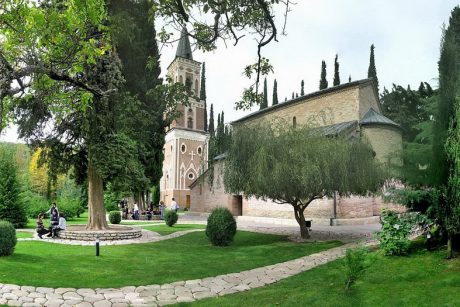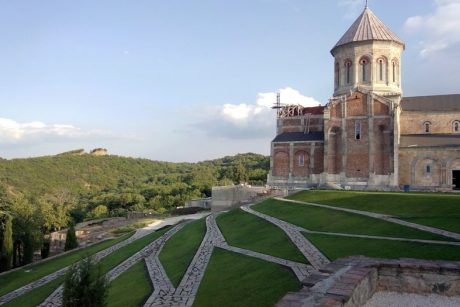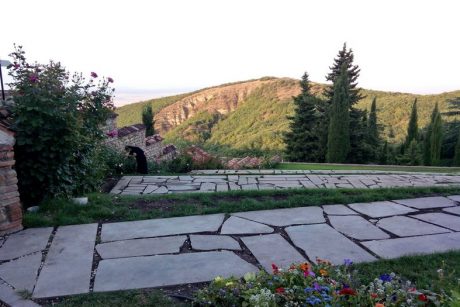Bodbe
Sighnaghi-St. Nino Monastery
the address
9th century
founding date
humid subtropical
climate
Sighnaghi
region
Why Bodbe?
The monastery occupies a rather large area and is very popular with tourists at the moment. Due to the fact that it is constantly maintained in good shape and updated with various interesting things, tourists pay more and more attention to this church every year. Very well thought out and made for visitors near the entrance to the monastery cafe and parking lot, very convenient for everyone. True, in the cafe there are no treats for lovers of meat and alcohol, these are the rules of the monastery. For the same reason, it is better to visit Bodbe Monastery on tours before feasts and picnics. There are two entrances to the territory of Bodbe Monastery. One for visitors, the other private for ministers and monks, we as visitors should move to the right entrance.
Entering the territory of the monastery, you will immediately feel the energy of this place. You will hear an ancient story about how Georgia adopted Christianity. Going inside the temple, you will have a unique opportunity to touch the sacred relics of St. Nino, who is the baptist of Georgia. Leaving the temple, you can walk along the wonderful courtyard of the monastery. At the end of the courtyard there is a platform from where you will see a huge part of the Alazani Valley and the ridge of the Caucasus Mountains.
How to get there?
The monastery is located very close to Sighnaghi - which means that it is not difficult to come here. Yes, and signs near Sighnaghi are everywhere on Bodbe. Of course, you can take a detour by car and get straight to the source. But it is necessary to have a well-traversed car and a brave driver.
prices
Visiting the territory of the monastery and the cathedral is free.
Working mode
Working hours - from 10:00 to 19:00. There is a refectory and a souvenir shop. You won’t be able to enter the Bodbe Monastery itself, since it is active.
Attractions
Interesting
History of the monastery
According to ancient records, it was possible to establish that after the death of St. Nino, at the beginning of the 4th century, a temple was erected over her grave in Bodba, and a monastery appeared nearby - it was constantly completed and expanded by successive kings. This place was highly respected not only by the Georgians, but even by the Tatar-Mongolians, who robbed and destroyed everything in their path, but did not touch the tomb, unlike the temple, which was seriously damaged by their raid. The monastery of St. Nina in the 15th century became such a popular and significant place that Kakhetian kings began to be crowned in it. In the 17th century, the Persian Shah Abbas I ravaged Bodbe, and the Kakhetian king Teimuraz I restored the monastery and opened a theological seminary there, which contains one of the largest collections of books on religious topics in the country. Since the 18th century, the monastery has been converted into a male monastery, with a large number of monks. After 1811, the Bodbe diocese was abolished by decree from the Russian Empire and the monastery fell into disrepair. Most of the land was taken from him, transferred to state security, and only a few monks were left to look after him. Despite all these difficulties, at this time, the famous icon painter and airbrush, Mikhail Sabinin, is working on the restoration of the tomb and the complex as a whole. In 1889, the Russian Emperor Alexander III visited Sighnaghi and admired the local nature so much that he ordered the opening of a nunnery in Bodbe. Literally immediately, they began to restore and restore it, returned the selected lands, opened a school of painting and needlework, and 12 women from various regions of the Russian Empire became the first nuns. Life was seething and seething, the number of sisters reached 300 and everything was going well until the Bolsheviks came in 1924 and completely ruined the monastery, turning it into a hospital. Only in 1991, the forces and means were found to start the restoration and revival of the Bodbe Monastery.
What to watch?
Arriving at the parking lot at the main gate, you can freely enter the territory of the monastery or have a bite to eat in the refectory "Pilgrim" near the parking lot. Inside, you immediately find yourself in a rather beautiful and well-groomed park with tall cypresses, paved paths, stone walls and ivy climbing over them. In the center of all this, the cathedral in the name of St. George stands modestly, admission is free, only photography is prohibited. Its architecture is slightly unusual for the average Russian person, because there are no domes on it, although in the 19th century one was built on orders from Russia, but it was dismantled under the Soviet regime. But inside the temple is no longer as modest as outside - one can feel the imprint of the Russian Orthodox Church. But what can be surprising here, given that it was erected in the period of the 9th-11th centuries, and then rebuilt, reconstructed and restored several times, which does not prevent it from being the center of the Signakh diocese. Nearby rises the bell tower of the XIX century. three floors - it is not a classic representative of Georgian church architecture, although it is in harmony with the surrounding buildings. From the park you can get directly to the territory of the Bodbe monastery itself, but all the gates are covered and signs hang on them that entry is prohibited there - do not forget that this is a women's monastery. We head to the left side, to the church shop with a glass wall, where you can buy all sorts of different things, and these are not just a few types of candles. Behind it is an observation platform. To the left of the observation deck, outbuildings with cows and other animals guarded by a huge kind dog with a very long chain And on the right side rises in all its glory the temple of St. Nina. Approaching it, you won’t immediately say so, but this is a typical remake, though built wisely. Brick cladding does not make it possible to determine the age of the building - everything is chosen correctly and harmonizes with neighboring, more ancient buildings.
St. Nina's Spring
Having enjoyed the beauty of the opening view, having examined the well-groomed flower beds, lawns and vines, it's time to start descending to the healing spring of St. Nino. In order to collect water there, people come from far away. There are two ways to get there: on foot through the forest and by car / on foot along the bypass road. On foot, you have to go down the stairs, which are laid through the forest and wind like a snake for 3 km, and have about 320 steps of various widths. There are often benches to rest along the way. It is better for people with problematic health or with sore legs to refrain from descending and ascending along this route. All the steps were made by hand, so they have completely different widths, which does not allow you to get into the rhythm and go down on the light, for example, one step can be 20 cm wide, and the second 1.5 meters. It is extremely inconvenient to go down in slippers, slates and other shoes that are not firmly seated on the leg - it is better to take off your shoes and go barefoot. The second route, by road, is easier, but also longer - 2 times. But you can get there by your car or with taxi drivers who are usually on duty, both in the parking lot at the monastery and near the source. Having finally gone down and out on a flat surface, two brick buildings begin to be seen because of the foliage. The right one, apparently, belongs to the caretaker, and the left one is the temple of Zabulon and Sosana (Nina's parents), built in the 1990s. Directly below it, on the other hand, is a font and a healing spring. To take a bath, you need to have a shirt or chiton with you, if you don’t have one, you can buy it at the entrance. The procedure itself is free. Men and women are allowed in alternately. The water is very cold - but it will cheer you up on the way back.

 TABERNE
TABERNE



